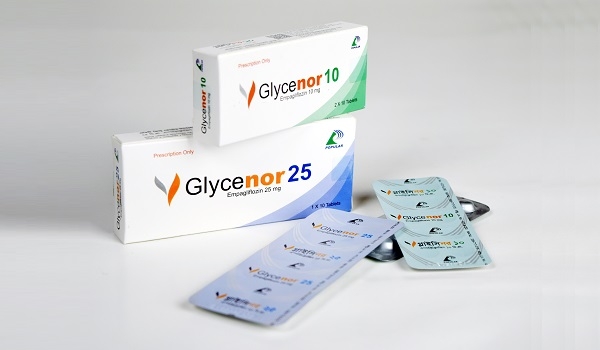ঔষধের বিস্তারিত বা বিকল্প ঔষধ জানতে ঔষধের নাম দিয়ে সার্চ দিন। যেমন- Napa বা Alatrol বা Amodis
Glycenor 25mg
TabletEmpagliflozin
Popular Pharmaceuticals Ltd
Other Strength:
- Glycenor 10mg
Alternative:
- Jardian 25mg
- Empatab 25mg
- Emjard™ 25mg
- Evania 25mg
- Empaglif 25mg
- Emjard Tablet 25mg
- Glifo 25mg

Glycenor
Indication
Empagliflozin is indicated for the treatment of adults with insufficiently controlled type 2 diabetes mellitus as an adjunct to diet and exercise
• as monotherapy when Metformin is considered inappropriate due to intolerance
• in addition to other medicinal products for the treatment of diabetes
It is also indicated to reduce the risk of cardiovascular death in adult patients with type 2 diabetes mellitus and established cardiovascular disease.
Dosage & Administration
The recommended starting dose is 10 mg Empagliflozin once daily as monotherapy and add-on combination therapy with other medicinal products for the treatment of type 2 diabetes. In patients tolerating Empagliflozin 10 mg once daily who have an eGFR ≥60 ml/min/1.73 m2 and need tighter glycaemic control, the dose can be increased to 25 mg once daily. The recommended maximum daily dose is 25 mg.
When Empagliflozin is used in combination with a sulphonylurea or with insulin, a lower dose of the sulphonylurea or insulin may be considered to reduce the risk of hypoglycaemia.
In patients with volume depletion, correcting this condition prior to initiation of Empagliflozin is recommended.
Patients with Renal Impairment: Assessment of renal function is recommended prior to initiation of Empagliflozin and periodically thereafter. Empagliflozin should not be initiated in patients with an eGFR less than 45 ml/min/1.73 m2. No dose adjustment is needed in patients with an eGFR greater than or equal to 45 ml/min/1.73 m2. Empagliflozin should be discontinued if eGFR is persistently less than 45 ml/min/1.73 m2.
Hepatic impairment: No dose adjustment is required for patients with hepatic impairment. Empagliflozin exposure is increased in patients with severe hepatic impairment. Therapeutic experience in patients with severe hepatic impairment is limited and therefore not recommended for use in this population.
Empagliflozin tablets can be taken with or without food, swallowed whole with water. If a dose is missed, it should be taken as soon as the patient remembers; however, a double dose should not be taken on the same day.
Precautions
Diabetic ketoacidosis (DKA): Empagliflozin should not be used in patients with type 1 diabetes or for the treatment of diabetic ketoacidosis (DKA). In patients where DKA is suspected or diagnosed, treatment with Empagliflozin should be discontinued immediately.
Hepatic injury: Cases of hepatic injury have been reported with Empagliflozin in clinical trials. A causal relationship between Empagliflozin and hepatic injury has not been established.
Risk for volume depletion: Based on the mode of action of SGLT-2 inhibitors, osmotic diuresis accompanying therapeutic glucosuria may lead to a modest decrease in blood pressure. Therefore, caution should be exercised in patients for whom an Empagliflozin-induced drop in blood pressure could pose a risk, such as patients with known cardiovascular disease, patients on anti-hypertensive therapy with a history of hypotension or patients aged 75 years and older. In case of conditions that may lead to fluid loss (e.g. gastrointestinal illness), careful monitoring of volume status and electrolytes is recommended for patients receiving Empagliflozin.
Urinary tract infections: Temporary interruption of Empagliflozin should be considered in patients with complicated urinary tract infections.
Fournier's gangrene: Fournier's gangrene is a rare but serious and potentially life-threatening event that requires urgent surgical intervention and antibiotic treatment. If Fournier's gangrene is suspected, Empagliflozin should be discontinued and prompt treatment (including antibiotics and surgical debridement) should be instituted.
Elderly: Patients aged 75 years and older may be at an increased risk of volume depletion. Special attention should be given to their volume intake in case of co-administered medicinal products which may lead to volume depletion (e.g. diuretics, ACE-inhibitors). Therapeutic experience in patients aged 85 years and older is limited. Initiation of Empagliflozin therapy in this population is not recommended.
Use in Pregnancy & Lactation
There are no adequate and well-controlled studies of Empagliflozin in pregnant women. Empagliflozin should be used during pregnancy only if the potential benefit justifies the potential risk to the fetus. It is not known if Empagliflozin is excreted in human milk. It is not recommended when breast feeding.
এই পাতাটি ২১১ বার দেখা হয়েছে
রাজডক কী?
ফ্রী সদস্য হোন Click Here
ডাক্তার হিসাবে যোগদান করতে Click Here
নার্স / টেকনোলজিস্ট হিসাবে যোগদান করতে Click Here
ফ্রী সদস্য হোন Click Here
ডাক্তার হিসাবে যোগদান করতে Click Here
নার্স / টেকনোলজিস্ট হিসাবে যোগদান করতে Click Here

